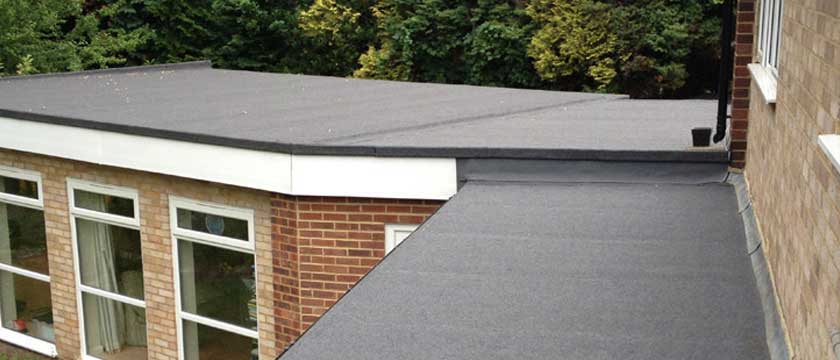A flat roof can be an excellent choice for residential properties, offering a modern, sleek appearance and efficient use of space. If you’re considering a flat roof installation for your home, it’s essential to understand the process, materials, and key considerations involved. In this blog, we’ll cover everything you need to know about flat-roof residential installations.
1. Understanding Flat Roofs:
Flat roofs are not entirely flat; they have a slight pitch to facilitate water drainage. Unlike sloped roofs, which use shingles or tiles, flat roofs typically employ different materials, such as built-up roofing (BUR), modified bitumen, EPDM rubber, TPO, or PVC membranes.
2. Professional Installation is Key:
First and foremost, it’s crucial to emphasize that flat roof installation is a complex and specialized task best left to experienced professionals. Unlike sloped roofs, flat roofs require precise techniques to ensure proper drainage and prevent leaks. Qualified roofers have the expertise, equipment, and materials necessary to achieve a successful flat roof installation.
3. Roof Inspection:
Before beginning the installation, a roofing professional will assess the condition of your existing roof and its structural components. This inspection helps identify any repairs or modifications needed to ensure a solid foundation for the new flat roof.
4. Material Selection:
Choosing the right roofing material is a critical decision. Here are some common options:
- Built-Up Roofing (BUR): BUR consists of multiple layers of bitumen and reinforcing fabrics, typically alternating between them. Gravel or a reflective coating is often applied to the top layer for protection.
- Modified Bitumen: Modified bitumen is a single-ply membrane that combines asphalt with modifiers for added durability. It’s available in various installation methods, including torch-applied, cold-applied, and self-adhered.
- EPDM: Ethylene Propylene Diene Monomer (EPDM) is a synthetic rubber roofing material known for its durability and flexibility. It’s typically applied to a single sheet and sealed at the seams.
- TPO and PVC Membranes: Thermoplastic Olefin (TPO) and Polyvinyl Chloride (PVC) membranes are single-ply roofing materials that offer energy efficiency and durability. They are heat-welded at the seams to create a watertight seal.
The choice of material depends on factors like budget, climate, and aesthetic preferences. Consult with your roofing contractor to determine the most suitable option for your home.
5. Proper Installation Process:
Flat roof installation involves several key steps:
- Deck Preparation: The existing roof deck is inspected, and any necessary repairs or modifications are made. The deck must be structurally sound and level to ensure a flat roof’s integrity.
- Insulation: Proper insulation is crucial for energy efficiency and moisture control. Insulation boards are installed over the roof deck to create a thermal barrier.
- Vapor Barrier: A vapor barrier is applied to prevent moisture from entering the building. It is especially important in climates with temperature variations.
- Roofing Membrane Installation: The chosen roofing material is applied according to the manufacturer’s specifications. It’s crucial to ensure proper overlaps and seals at seams and penetrations.
- Flashing and Edge Details: Flashing is installed around roof penetrations, parapet walls, and the roof’s edges to prevent water infiltration.
- Drainage System: A well-designed drainage system is essential for flat roofs. Properly placed drains, scuppers, and gutters ensure efficient water runoff.
6. Maintenance and Repairs:
Regular maintenance is essential to extending the life of your flat roof. Inspections, cleaning, and prompt repairs are key to preventing issues such as leaks and damage. A professional roofing contractor can provide a maintenance plan tailored to your specific roof type.
7. Cost Considerations:
The cost of a flat roof installation varies depending on factors such as the chosen material, roof size, and geographic location. It’s advisable to obtain multiple quotes from reputable roofing contractors to ensure a competitive price.
8. Permits and Regulations:
Before embarking on a flat roof installation project, check with your local building department to determine if permits are required and if there are any specific regulations you need to follow. Compliance with local building codes is essential to ensuring a safe and legal installation.
In Conclusion:
Flat-roof residential installations offer a contemporary and space-efficient roofing solution for modern homes. To ensure a successful installation that provides long-lasting protection, it’s vital to work with professional roofing contractors who specialize in flat roofs. By choosing the right roofing material, following proper installation procedures, and implementing regular maintenance, you can enjoy the benefits of a functional and aesthetically pleasing flat roof for years to come.
Spring Roofing https://www.springtexasroofers.com/

